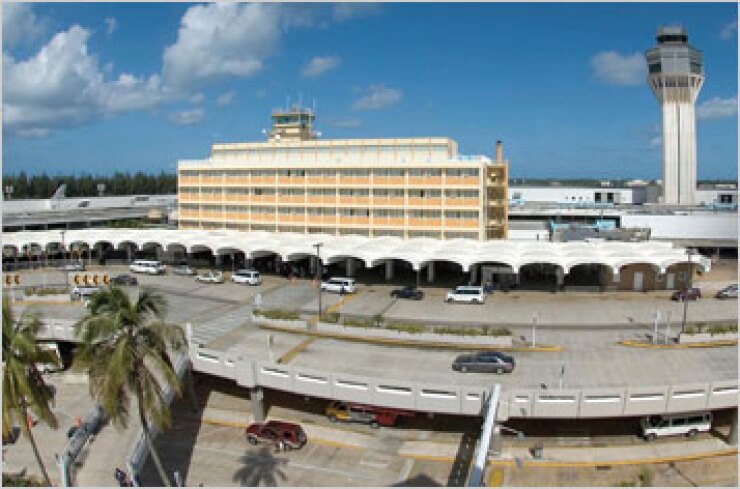
Mexico’s Aerostar Airport Holdings LLC won a 40-year concession to lease operate San Juan’s Luis Muñoz Marín International Airport, submitting a $2.6 billion bid to the Puerto Rican government.
The 19-month competition for the Caribbean’s biggest airport attracted some of investment banking’s most prominent names worldwide.
It is the first public-private partnership for a medium-hub airport announced under a Federal Aviation Administration pilot program.
“Each city will have to do its own analysis and make its own decision, but there is definitely room for these kinds of projects within the FAA pilot program,” David Álvarez, the executive director of the Puerto Rico Public-Private Partnerships Authority, said in an interview.
“This has the potential for a very big upside,” added Juan Carlos Pavía, the director of the commonwealth’s Office of Management and Budget.
In addition to modernizing the airport, officials expect the P3 project to reduce the debt of the Puerto Rico Ports Authority, which operates the facility.
Aerostar consists of Grupo Aeroportuario del Sureste SAB de CV, or Asur, which operates nine airports in southeast Mexico, and New York private equity firm Highstar Capital.
“It’s a long time in coming and everybody is happy to see it happen,” said Thomas Osborne, a managing director and head of Americas infrastructure for UBS Investment Bank.
UBS was the lead advisor and financial and strategic advisor to the consortium, Highstar and Asur.
Royal Bank of Canada advised on the financing.
The runner-up consortium, Grupo Aeropuertos, included Ferrovial Aeropuertos, which operates six United Kingdom airports, and Australia’s Macquarie, the world’s largest infrastructure investment fund.
Puerto Rico officials expect to close on the financing in December. Aerostar will pay the Ports Authority about $615 upfront.
Asur and Highstar Capital IV are expected to contribute financing and equity contributions on a 50-50 basis, according to a statement from Asur.
Although the airport handles more than 8.5 million passengers yearly and recently opened a terminal that JetBlue Airways occupies, commonwealth officials say it lagged key Caribbean peers in total passenger growth.
Traffic at LMM declined when Dominican Republic and Miami airports built out in 2008.
San Juan also has lost European inbound market share to the Dominican since 2005.
According to a study by the P3 Authority, aviation revenues at LMM ,which sits just outside San Juan, in Carolina, remained flat from 2007 to 2010, while overall revenues were down 10%, excluding bad debts.
That agency also said LMM had underperformed significantly in food and beverage, car rental and parking revenues on a per-passenger yield basis.
Aerostar’s management of the Cancún International Airport in Mexico, which is similar in size and competition to San Juan, especially appealed to commonwealth officials.
“There’s a misconception that managing an airport just means taking care of the premises,” said Puerto Rico Treasurer Jesús Méndez.
“There’s more than that,” he added. “You have to have good communications with the airlines, for example.”
Puerto Rico is no stranger to P3 projects, having privatized its main highway, PR-22, and before that, the Teodoro Moscoso Bridge.
“The Puerto Rico P3 program has some of the most favorable characteristics of any other state’s or commonwealth’s. Puerto Rico’s P3 Authority has a clearly defined legal foundation and a clean, well-understood approvals process,” according to Osborne.
Méndez, though, acknowledged the degree of difficulty in airport projects. “You have a very complex regulatory environment,” he said.
The airport announcement coincided with commonwealth officials’ angry reaction to Wednesday’s downgrade by Moody’s Investors Service of $6.8 billion of Puerto Rico Sales Tax Financing Corp., or Cofina, outstanding senior sales tax revenue bonds to Aa3 from Aa2, and $9.2 billion subordinate bonds two notches, to A3 from A1.
Moody’s cited increased risk in the bonds’ escalating debt service because of the extended recession coupled with structural changes in the manufacturing sector due to the phase-out of territorial tax benefits and exposure to increased global competition.
“The combined result is that the commonwealth’s economy is expected to underperform compared to the U.S. economy,” Moody’s said in a report.
On Friday, commonwealth officials came out swinging.
In a conference call with investors, Pavia, Mendez and Government Development Bank executives José Otero and Ian Figueroa called Moody’s actions unreasonable, arguing that sales-tax collections are up 3.1% and the island’s overall economy is poised to grow for the first time since 2006.
They said Moody’s had upgraded Cofina in 2009, when the economy was contracting at a 3.8% rate and sales-tax collections were down 4.7%.
Speaking by telephone after the meeting, Pavía called the airport deal and the ratings downgrade “a contrast between real investors and rating agency people that sit behind a desk.”
He went on to say that “the ratings actions are unwarranted, and rest assured we will keep discussing the matter with Moody’s.”





